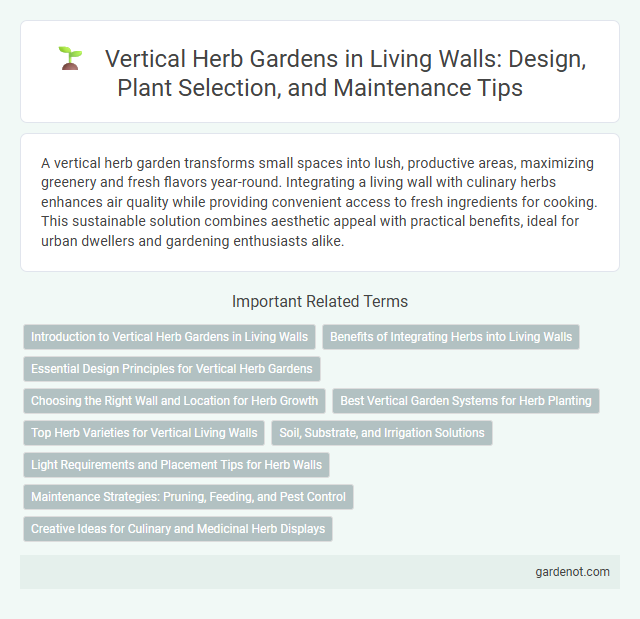A vertical herb garden transforms small spaces into lush, productive areas, maximizing greenery and fresh flavors year-round. Integrating a living wall with culinary herbs enhances air quality while providing convenient access to fresh ingredients for cooking. This sustainable solution combines aesthetic appeal with practical benefits, ideal for urban dwellers and gardening enthusiasts alike.
Introduction to Vertical Herb Gardens in Living Walls
Vertical herb gardens integrated into living walls maximize space utilization while enhancing air quality and aesthetic appeal. These sustainable installations support a variety of herbs such as basil, thyme, and mint, thriving through efficient irrigation systems and nutrient-rich substrates. Incorporating vertical herb gardens promotes urban greening and offers fresh, accessible herbs for culinary and medicinal use.
Benefits of Integrating Herbs into Living Walls
Integrating herbs into living walls enhances air quality by naturally filtering pollutants and releasing oxygen. Vertical herb gardens maximize space efficiency while providing fresh, aromatic herbs for culinary and medicinal use. This sustainable gardening method also promotes biodiversity and supports urban ecosystems by attracting beneficial insects.
Essential Design Principles for Vertical Herb Gardens
Vertical herb gardens maximize small spaces by utilizing modular structures that ensure adequate sunlight and ventilation for each plant. Selecting lightweight, durable materials like wood or recycled plastic enhances stability and moisture control, crucial for healthy root development. Proper irrigation systems and strategic plant placement according to sun exposure optimize growth and ease of maintenance in vertical herb gardens.
Choosing the Right Wall and Location for Herb Growth
Selecting the ideal wall for a vertical herb garden involves considering sunlight exposure, wall material, and proximity to water sources to ensure optimal herb growth. South-facing walls generally provide ample sunlight, promoting healthy photosynthesis and vigorous plant development. Choosing walls with sturdy construction and good drainage prevents structural damage and root rot, enhancing the longevity and productivity of the herb garden.
Best Vertical Garden Systems for Herb Planting
Best vertical garden systems for herb planting maximize space with modular panels made from durable, UV-resistant materials, ensuring optimal growth conditions and easy maintenance. Systems featuring self-watering reservoirs and adjustable light exposure enhance herb vitality by providing consistent moisture and tailored sunlight absorption. Popular options include wall-mounted pockets, tiered planters, and hydroponic setups that support diverse herb varieties while improving indoor air quality and aesthetics.
Top Herb Varieties for Vertical Living Walls
Basil, mint, and thyme are among the top herb varieties ideal for vertical living walls due to their compact growth and high yield. These herbs thrive in well-drained soil and require moderate sunlight, making them perfect for vertical garden systems. Incorporating rosemary and oregano enhances flavor diversity while promoting pest resistance in vertical herb gardens.
Soil, Substrate, and Irrigation Solutions
Vertical herb gardens thrive with well-draining, nutrient-rich soil or soilless substrates like coconut coir and perlite, which provide optimal aeration and moisture retention. Advanced irrigation solutions, such as drip systems and automated timers, maintain consistent hydration, preventing water stress and promoting healthy root development. Incorporating moisture sensors optimizes water use efficiency, ensuring herbs receive precise irrigation tailored to their growth needs.
Light Requirements and Placement Tips for Herb Walls
Vertical herb gardens thrive best in locations receiving 6 to 8 hours of direct sunlight daily, essential for herbs like basil, rosemary, and thyme. Positioning the living wall on south or southwest-facing walls maximizes light exposure, while avoiding shaded areas or proximity to large trees. Using grow lights can supplement natural light in indoor or low-sun environments, ensuring healthy growth and robust herb yields.
Maintenance Strategies: Pruning, Feeding, and Pest Control
Regular pruning in vertical herb gardens promotes healthy growth by removing dead or overgrown foliage, ensuring optimal light exposure and air circulation. Strategic feeding with balanced organic fertilizers supports nutrient needs tailored to specific herb varieties, enhancing flavor and yield. Integrated pest control methods, such as introducing beneficial insects and using natural repellents, effectively reduce infestations while maintaining the garden's ecological balance.
Creative Ideas for Culinary and Medicinal Herb Displays
Vertical herb gardens transform kitchens and outdoor spaces by maximizing limited square footage with lush, fragrant greenery. Innovative designs feature tiered wooden crates, repurposed pallets, and modular pocket planters that organize culinary and medicinal herbs like basil, rosemary, and chamomile vertically for easy harvesting. Integrating drip irrigation systems and adjustable lighting enhances growth while creating visually stunning, functional living walls that inspire wellness and gourmet cooking.
Vertical herb garden Infographic

 gardenot.com
gardenot.com